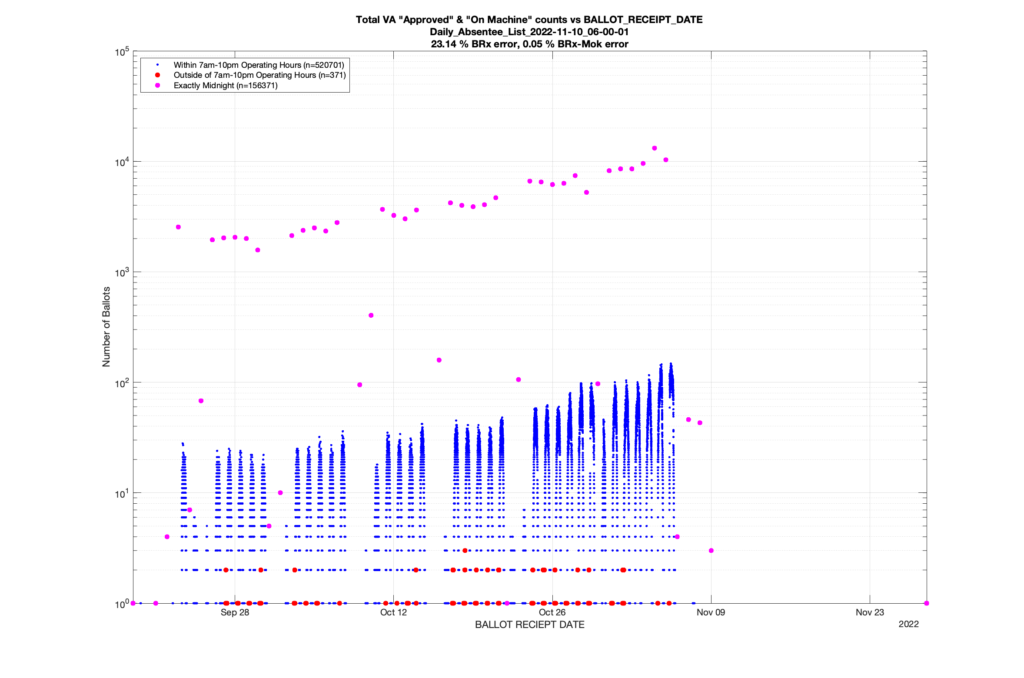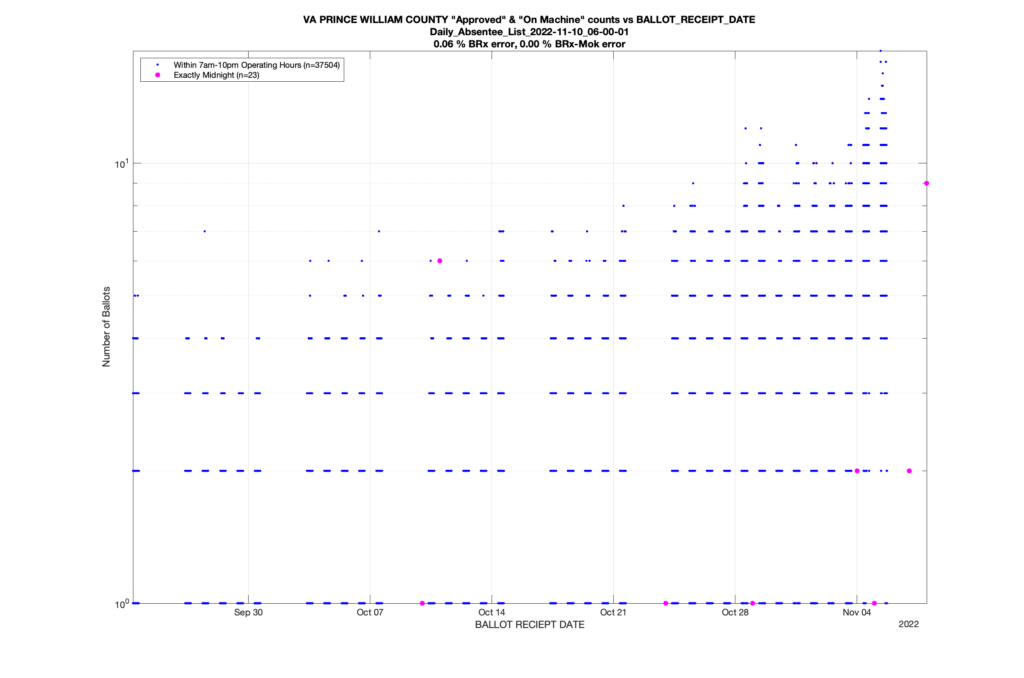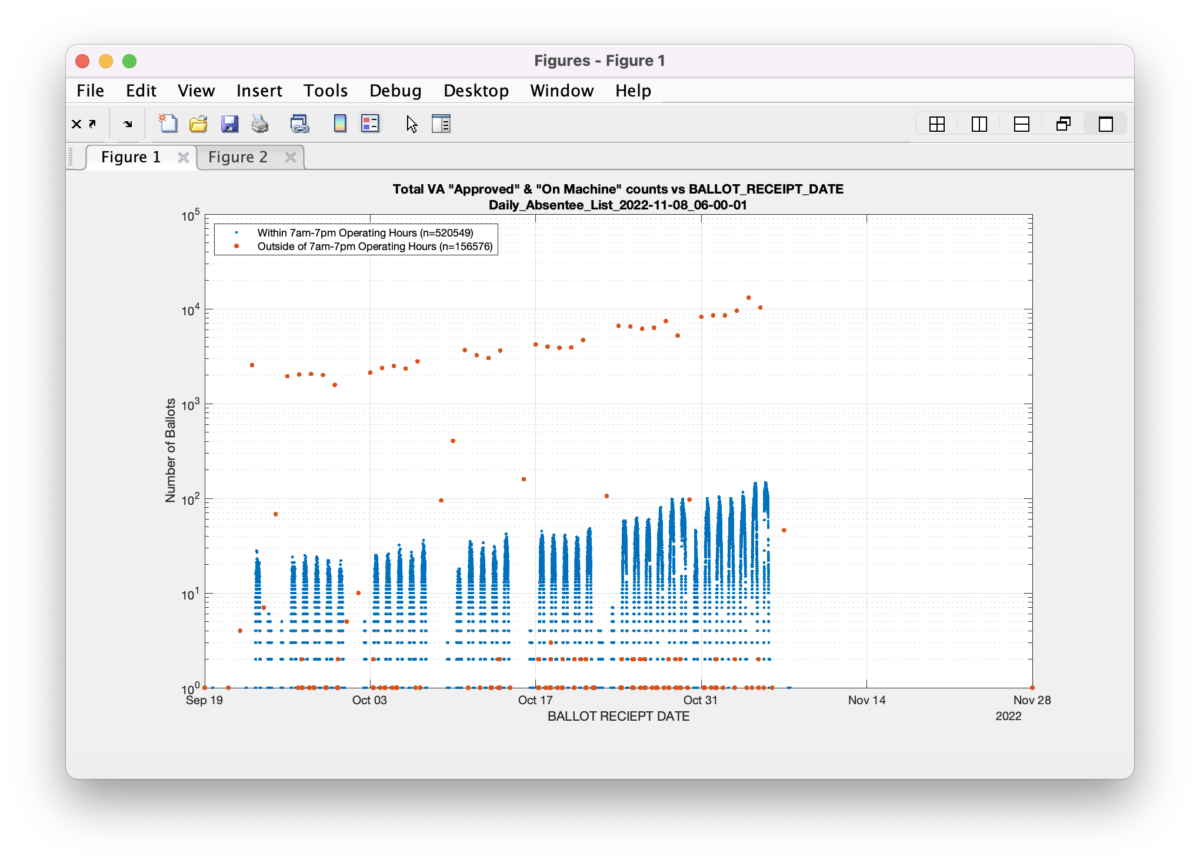In looking over the VA DAL data, one interesting issue that is readily apparent, is that the BALLOT_RECIEPT_DATE field for in-person, on-machine early vote data is logically impossible.
These time-stamps are supposed to be generated by the electronic poll-books when a voter is checked in at an in-person early voting site. The appeal and rationale for utilizing electronic poll-books is exactly because the can automate the recording of check-in and (theoretically) minimize human error. The operating hours of VA in-person early voting sites are limited to 7am – 7pm. I’m not aware of any in-person early voting center that had extended hours past those. Therefore, logically, we would expect that the electronic poll book generated time stamps for check-ins for in-person on-machine early votes would fall within the 7am – 7pm bounds.
The plot below is generated directly from the Daily Absentee List (DAL) file pulled from the VA Department of Elections on 11/08/2022 at 6am. The x-axis gives the time (rounded to the nearest minute) of the BALLOT_RECIEPT_DATE field associated with recorded Early In-Person On-Machine ballots in the file. The (logrithmic) y-axis gives the total number of Early In-Person On-Machine records that were recorded with that unique timestamp. The blue trace represents all of the records that fall within the daily 7am – 7pm bounds, and the red trace represents the data outside of those bounds.
There were 520,549 records that fall within the expected time bounds, and 156,576 that fall outside of the bounds. From a purely systems perspective, that means that the ability of our electronic poll books (or the backend database they are tied to) to accurately record the check-in time of Early In-Person On-Machine voters has an error rate of 156576 / (156576+520549) = 23.12%.
Let me say that again. A 23.12% error rate.
23.12% of the time, our electronic poll-book based system is reporting a logically impossible time for a person to have physically walked into an open + operating early voting location to check-in and cast their ballot.

Now, if we want to be generous and allow for the possibility that maybe voting locations opened early or closed late and we pad our (7am – 7pm) bounds to be from (6am – 8pm) and run the same analysis, we still get an error rate of 23.09%.
If we pad the hours of operations limits even further to (5am – 9pm), we still get an error rate of 23.06%.
If we run the same analysis using the 7am – 7pm bounds on the 2021 and 2020 data we get 29.64% and 71.17% error rates, respectively.


Update 2022-11-13
I adjusted the allowed times to 7am-10pm and re-ran the most recent 2022, 2021 and 2020 DAL files, as well as breaking down by locality. While doing this I noticed that some localities had all timestamps set to midnight, while others still had invalid timestamps set to unique values (but outside operational hours), and some had combinations of both. I’ve delineated the plots such that magenta traces are from ballot receipt timestamps that are all set to midnight, red trace is invalid timestamps not set to midnight, and blue traces are valid within 7am-10pm hours of operation (which is very very generous).
There are two error percentages being computed and being displayrd in the graph title area. The first (“BRx error”) is as described above and results in a 23.14% error in the 2022 VA statewide data. The second (“BRx_Mok error”) is as described above except we allow for the uniformly midnight ballot receipt dates to be presumed allowable, and results in a 0.05% error metric.
The inclusion of the latter class of error computation is in order to account for the remote chance that a locality is legitimately using paper poll books or otherwise not recording the time of the voter checkin, but only recording the date information (which would be consistent with all timestamps at midnight). VA requires the use of electronic poll books, but there are still some that use manual entry paper poll-books as backup. So even IF that was the explanation for why so many entries were uniformly timestamped to midnight … (A) why did they have to go to their paper poll book backups in the first place? and (B) we still have a residual error of 0.05% across the state that needs to be explained even after removing uniform midnight timestamps from consideration. That might not seem a terribly huge error rate at first blush, but when you consider that most electronic data recording systems (at least that I am aware of) have error rate requirement thresholds for acceptance testing set to the order of 1/1,000,000 … thats still unacceptable. I have been unable to find a documented requirement for error rate threshold for the electronic poll book systems used in VA, as per the VA department of elections.

The complete tabulation of all errors for each locality is provided here:
Selected Locality Plots:
The segmented Prince William County (my home county) 2022 plot is below. There is a 0.06% error rate of invalid (all midnight) timestamps in the Ballot Receipt date data.

The segmented Loudoun County 2022 plot is below. There is a 0.03% error rate of invalid (all midnight) timestamps in the Ballot Receipt date data.

The segmented Manassass City 2022 plot is below. There is a 5.82% error rate of invalid (all midnight) timestamps in the Ballot Receipt date data.

The segmented Mathews County 2022 plot is below. There is a 24.21% error rate of total invalid timestamps in the Ballot Receipt date data, and a reduced error rate of 15.71% when allowing all midnight timestamps to be considered as valid.

The segmented Virginia Beach City 2022 plot is below. There is a 0.24% error rate of invalid (all midnight) timestamps in the Ballot Receipt date data.

The complete set of generated plots for every locality is included in the attached zip file:
